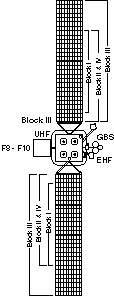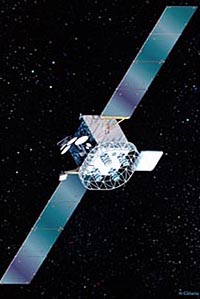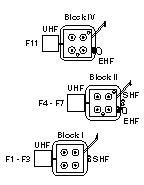 
The U.S. Navy began replacing and upgrading its ultra-high frequency (UHF) satellite communications network during the 1990s with a constellation of customized Hughes 601 spacecraft known as the UHF Follow-On (UFO) series. These satellites support the Navy's global communications network, serving ships at sea and a variety of other U.S. military fixed and mobile terminals. They are compatible with ground- and sea-based terminals already in service. In October 2000, The Boeing Company acquired three units within Hughes Electronics Corporation: Hughes Space and Communications Company, Hughes Electron Dynamics, and Spectrolab, Inc., in addition to Hughes Electronics' interest in HRL, the company's primary research laboratory. The four are now part of Boeing's newest subsidiary, Boeing Satellite Systems, Inc. In July 1988, Hughes Space and Communications Company won the competition for a fixed-price contract awarded by the Program Executive Office for Space, Communications, and Sensors in Washington, D.C. The initial agreement called for Hughes to build and launch one satellite, with options for nine more. Options for spacecraft 2 and 3 were exercised in May 1990; for 4, 5, and 6 in November 1990; and for 7, 8, and 9 in November 1991. In January 1994, the customer extended the contract by ordering a 10th satellite and launch services, bringing the total value to $1.7 billion. In March 1996, for an additional $150 million, the Navy ordered a high-power, high-speed Global Broadcast Service (GBS) payload to be incorporated onto the last three satellites. This GBS package is revolutionizing communications for the full range of the Defense Department's high-capacity requirements, from intelligence dissemination to quality-of-life programming. The first GBS payload was put into service in 1998, and the final one was launched in November 1999. Also in November 1999, the Space and Naval Warfare Systems Command's Communications Satellite Program Office added an 11th satellite to the contract. Choice of launch vehicle and responsibility for providing launch services are among options that could bring the total value of the project to $213 million. This will help sustain the constellation into the latter part of the decade. The UFO spacecraft has proven to be a very flexible platform for the efficient evolution of critical, advanced DOD communications services. The satellites are versions of the body-stabilized, three-axis Hughes 601 model. The spacecraft was introduced in 1987 to meet anticipated requirements for high-power, multiple-payload satellites for such applications as UFO, direct television broadcasting to very small terminals, private business networks, and mobile communications. The Boeing 601 body is composed of two main modules. The bus module houses the bus electronics, propulsion subsystem, and battery packs. The payload module contains the communications equipment and antennas. The UHF Follow-On contract calls for a minimum 10-year mission. The UHF Follow-On satellites replace the Fleet Satellite Communications (FLTSATCOM) and the Hughes-built Leasat spacecraft. The UFO satellites were manufactured in El Segundo, California. Using a building-block approach, Hughes and the Navy enhanced the constellation's capabilities in stages. Satellites F-1 through 3 carry UHF and SHF (super-high frequency) payloads. Starting with F-4 there is an additional payload for EHF (extremely high frequency) communications. F-7 introduced an enhancement to the EHF package that essentially doubles capacity. The SHF payload is replaced by the GBS package on F-8 through 10. F-11 carries the enhanced EHF package and an upgraded UHF payload as well. The UFO satellites offer increased communications channel capacity over the same frequency spectrum used by previous systems. Each spacecraft has 11 solid-state UHF amplifiers and 39 UHF channels with a total 555 kHz bandwidth. The UHF payload comprises 21 narrowband channels at 5 kHz each and 17 relay channels at 25 kHz. In comparison, FLTSATCOM offers 22 channels. The F-1 through F-7 spacecraft include an SHF subsystem, which provides command and ranging capabilities when the satellite is on station as well as the secure uplink for Fleet Broadcast service, which is downlinked at UHF. The Navy has added an extremely high frequency communications package beginning with the fourth spacecraft. This addition includes 11 EHF channels distributed between an earth coverage beam and a steerable 5° spot beam and is compatible with Milstar ground terminals. The EHF subsystem provides enhanced antijam telemetry, command, broadcast, and fleet interconnectivity communications, using advanced signal processing techniques. The EHF Fleet Broadcast capability supersedes the need for the SHF fleet uplink. Beginning with UFO F-7, the EHF package has been enhanced to provide 20 channels through the use of advanced digital integrated circuit technology. The GBS payload replaces the SHF payload on spacecraft F-8, 9, and 10. This new package includes four 130-watt, 24 megabits-per-second (Mbps) military Ka-band (30/20 GHz) transponders with three steerable downlink spot beam antennas (2 at 500 nmi and 1 at 2000 nmi) as well as one steerable and one fixed uplink antenna. This modification results in a 96 Mbps capability per satellite. Three spacecraft give the DOD near-global coverage. Integrating the GBS payload required several spacecraft modifications. The Ka-band traveling-wave tube amplifiers are integrated onto a larger south radiator panel with heat pipes added to accommodate the increased thermal dissipation. The GBS fixed receive antenna, together with the forward omni antenna, is mounted on the structure previously used for the SHF antennas. The GBS steerable receive antenna is mounted on a deployable boom. A new pallet structure has been added to integrate the three GBS transmit spot beam antennas. The nickel-hydrogen battery, which supports eclipse operations, has been enlarged to 164 from 126 amp-hour cells. F-11 will be most similar to F-7, providing UHF and enhanced EHF communications. The first seven satellites and F-11 measure more than 60 feet long from the tip of one three-panel solar array wing to the tip of the other. Spacecraft F-8 through F-10 each have four solar panels on a side, making them 75 feet long. These arrays generate a combined 2500 watts of electrical power on the first three satellites, 2800 watts for F-4 through F-7 and F-11, and 3800 watts for F-8 through F-10 with GBS. The arrays are folded against the spacecraft bus for launch, forming a cube roughly 11 feet per side. The satellites weigh an average of 2600 pounds with the UHF payload, 3000 pounds with the additional EHF payload, and 3400 pounds with the GBS payload. The Atlas rocket series were chosen to provide the launches from Cape Canaveral, Fla. The Atlas I rocket was used for the F-1 through F-3 satellites. The Atlas II was chosen for F-4 through F-8 and Atlas IIA for F-9 and F-10. The vehicle for F-11 is to be determined. Launch is set for 2003. UHF F-2 was the first in the series to go into service, after its successful launch Sept. 3, 1993. UHF F-3 was launched June 24, 1994. Three UHF spacecraft were orbited in 1995: F-4 on Jan. 28, F-5 on May 31, and F-6 on Oct. 22. F-7 was launched July 25, 1996. F-8 was launched March 16, 1998, and F-9 on Oct. 20, 1998. F-10 was launched November 22, 1999. F-11 is expected to be launched in 2003. |
||||||||||||||||||||


